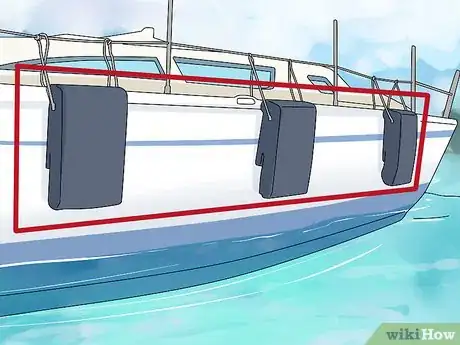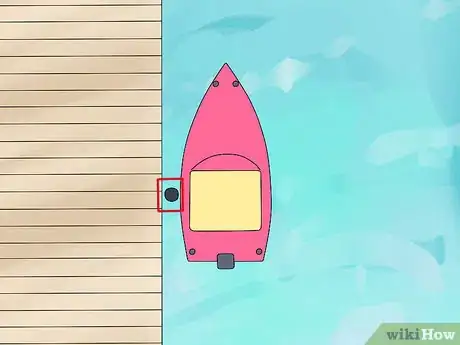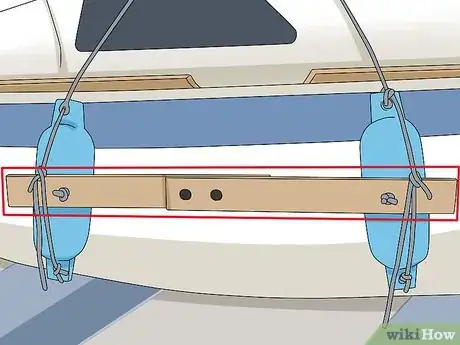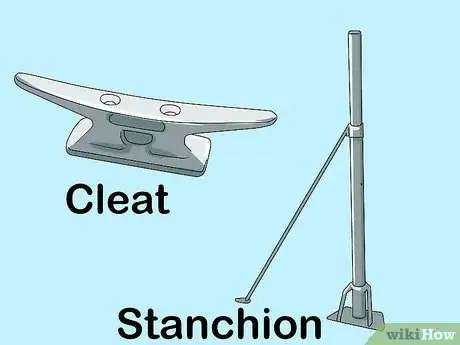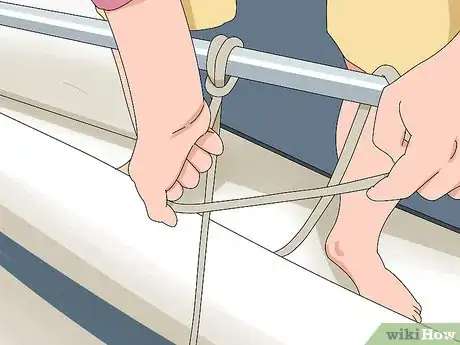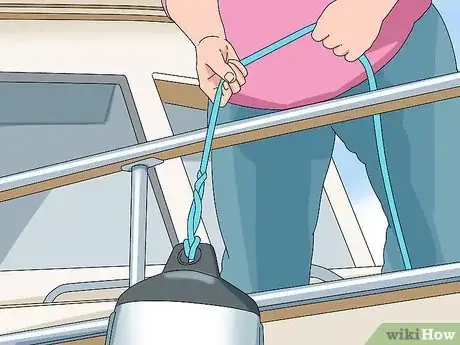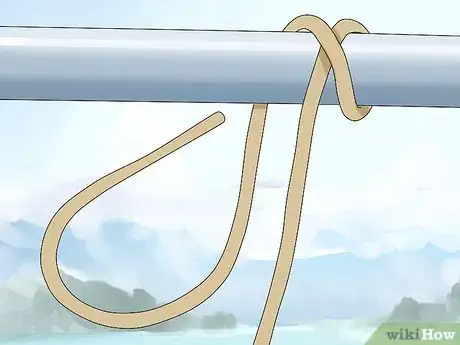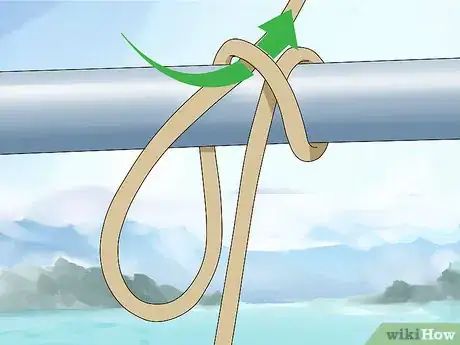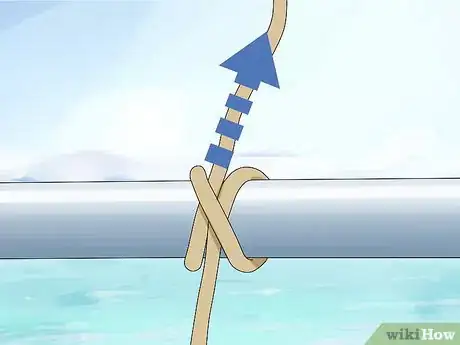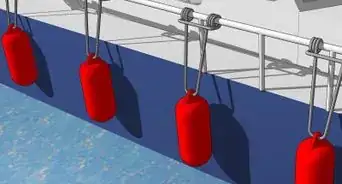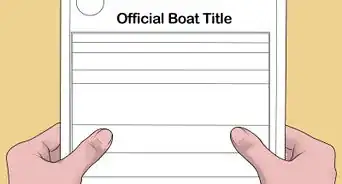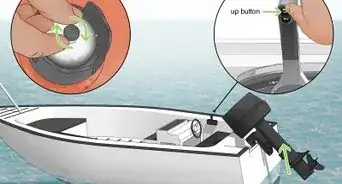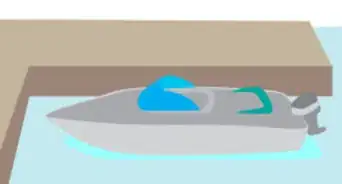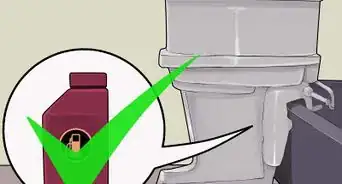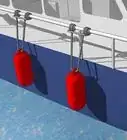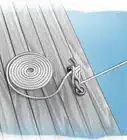This article was co-authored by Travis Lund. Travis Lund is the General Manager at the Vallejo Marina, a large marina located between the San Francisco Bay and the Delta in California. Sailing since he was six-years-old, Travis has over 15 years working in sailing operations and instruction and has pioneered a coaching platform that combined traditional coaching with multi-camera video support. He studied English at Michigan State University, where he was on the sailing team.
There are 7 references cited in this article, which can be found at the bottom of the page.
This article has been viewed 95,640 times.
Fenders help protect the edges of a boat from bumping up against things like docks, seawalls, and other boats. Stand on your boat to correctly position the fender, adjusting its height so that it correlates with the dock or whatever else you're protecting your boat from. You can use a clove hitch knot to secure the fender to a cleat or stanchion.
Steps
Spacing the Fenders
-
1Use at least 3 fenders on your boat. A boat should have at least 3 fenders tied to it to protect it efficiently, more always being a good option. You can follow the guidelines of having 1 fender per 10 feet (300 cm) of waterline while also always having a minimum of 3 fenders.[1]
-
2Place 1 fender at the widest part of the boat. The widest part of your boat is the part that will bump into something first along the sides, so you definitely want to place a fender at this section.[2]
- You can place other fenders forward and aft.
Advertisement -
3Use a fender board if the spaces between pilings are big. Sometimes your boat will bump into pilings even if they have fenders attached if the spaces between the pilings are large. To prevent this, you can use fender boards which connect to 2 fenders, forming a barrier against the pilings.[3]
Positioning Your Fenders
-
1Orient your fenders either horizontally or vertically. When you're choosing the position of your fenders, think about what your boat is going to come into contact with.[4] If your boat will be stationed next to another boat, by a dock, or by a seawall, you’ll want to tie the fenders on going vertically. If your boat will be next to pilings or posts, choose to tie them horizontally.[5]
-
2Choose something solid and low to tie your fenders to. You want to tie the fenders as low on the boat as possible, choosing something sturdy such as a cleat, a lifeline stanchion, or a padeye.[6] Tying them low will help keep them steady and prevent them from swinging around too much.[7]
- Avoid tying fenders to the top of a lifeline or rail.
-
3Stand on the boat to adjust the fender heights. Position yourself next to what you'll be protecting your boat from bumping against to decide where to position the fenders. Stand on your boat when adjusting the fenders, next to the dock, boat, or other structure.[8]
-
4Adjust the fenders according to what they’re lying against. When you’re holding the fender over the boat, position it so that it becomes a buffer between the boat and the dock or other structure. You should raise or lower the fenders depending on the height of what you’re protecting your boat from.[9]
Tying a Clove Hitch or Similar Knot
-
1Lay the line over the bar to begin a clove hitch knot. With the fender hanging off the side of the boat, lay the working end of the line over the rail or bar.[10]
- The working end of the line is the end that you'll use to tie the knot — the end not attached to a fender.
-
2Wrap the line halfway around the rail or bar. Once the line is laying on the rail, wrap it underneath the rail.[11]
-
3Cross the line over the wrapped part. Pull the working end of the line up and over the part of the line that's still laying on the rail. You should have formed an "X" with the line.[12]
-
4Wrap the working end of the line around the rail again. Complete the "X" by pulling the line under and half-way around the rail 1 more time.[13]
-
5Pull the running end through the loop you've created. Once the line is half-way around the rail, you'll have created a loop. Pull the working end of the line underneath this loop, pulling the line tightly.[14]
- The weight of the fender will pull down on the knot, keeping it tight and in place.
-
6Use a half hitch knot as a simple alternative. To tie a half hitch knot, lay the line around the rail, bringing the end under the standing part of the line. Pull the end of the line up through the loop you just created. Pull it tightly to secure it.[15]
- You can repeat this process to create several half hitches, making your line even more secure.
- Use half hitches if you're attaching the fenders to a lifeline.[16]
Expert Q&A
Did you know you can get expert answers for this article?
Unlock expert answers by supporting wikiHow
-
QuestionHow should I position the fenders on my boat?
 Travis LundTravis Lund is the General Manager at the Vallejo Marina, a large marina located between the San Francisco Bay and the Delta in California. Sailing since he was six-years-old, Travis has over 15 years working in sailing operations and instruction and has pioneered a coaching platform that combined traditional coaching with multi-camera video support. He studied English at Michigan State University, where he was on the sailing team.
Travis LundTravis Lund is the General Manager at the Vallejo Marina, a large marina located between the San Francisco Bay and the Delta in California. Sailing since he was six-years-old, Travis has over 15 years working in sailing operations and instruction and has pioneered a coaching platform that combined traditional coaching with multi-camera video support. He studied English at Michigan State University, where he was on the sailing team.
Sailing Instructor & Executive Director, Treasure Island Sailing Center
References
- ↑ http://www.anchoring.com/blog/boat-fenders-protecting-your-investment/
- ↑ http://www.anchoring.com/blog/boat-fenders-protecting-your-investment/
- ↑ http://www.boatus.com/magazine/trailering/2016/october/how-to-properly-place-a-fender.asp
- ↑ Travis Lund. Sailing Instructor & Executive Director, Treasure Island Sailing Center. Expert Interview. 24 April 2020.
- ↑ http://www.boatus.com/magazine/trailering/2016/october/how-to-properly-place-a-fender.asp
- ↑ Travis Lund. Sailing Instructor & Executive Director, Treasure Island Sailing Center. Expert Interview. 24 April 2020.
- ↑ http://www.boatus.com/magazine/trailering/2016/october/how-to-properly-place-a-fender.asp
- ↑ https://www.youtube.com/watch?v=c0SpikA00RI
- ↑ https://goneoutdoors.com/tie-boat-fenders-5845037.html
- ↑ https://www.youtube.com/watch?v=yyBgsaJzBgA
- ↑ https://www.youtube.com/watch?v=yyBgsaJzBgA
- ↑ https://www.youtube.com/watch?v=yyBgsaJzBgA
- ↑ https://www.youtube.com/watch?v=yyBgsaJzBgA
- ↑ https://www.youtube.com/watch?v=yyBgsaJzBgA
- ↑ https://www.youtube.com/watch?v=8ewvDw9iDh8
- ↑ Travis Lund. Sailing Instructor & Executive Director, Treasure Island Sailing Center. Expert Interview. 24 April 2020.
About This Article
Fenders are useful for protecting the edges of your boat when it bumps into things like docks, seawalls, and other boats. You’ll want to install at least 3 fenders on each side of your boat to adequately protect it. One should go at the widest part of the boat, then 2 or more spaced evenly apart from the middle. If your boat will be stationed next to another boat, dock, or by a seawall, you should orient the fenders vertically. If it will be next to pilings or posts, tie them on horizontally. Once you have your fenders, you’ll need to tie them onto the boat as low as possible. With the fender hanging off the side of the boat, use a clove hitch or similar knot to tie the fenders in place with rope. To learn how to use fender boards for extra protection, read on!
